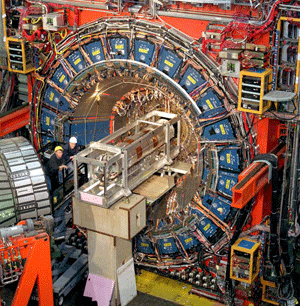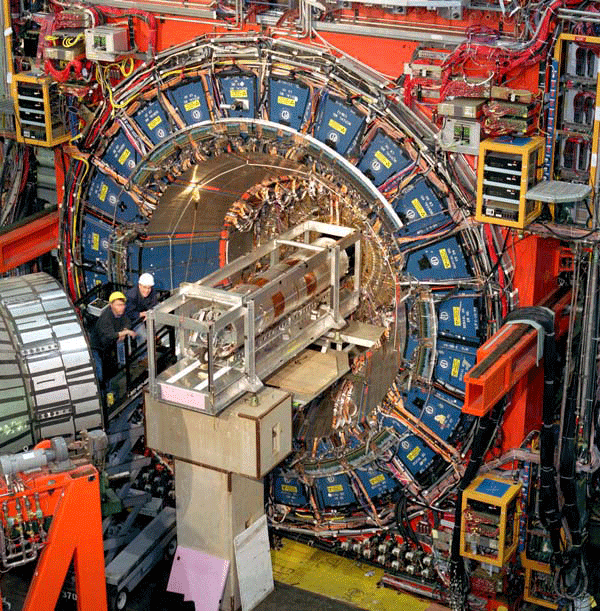A Fuller Picture of the Higgs Boson
In the history of particle physics, 2012 will be remembered as a milestone. On July 4th, 2012, two experimental groups, ATLAS and CMS, which run independent detectors at the Large Hadron Collider (LHC), announced that after a year of dedicated searches for the Higgs boson, they had discovered a new particle with a mass of 125 giga-electron-volts (GeV). At this stage, we cannot yet be sure if this particle is really a Higgs boson, and additional studies and experimental verification will be needed to pin the new particle down. For now, the next set of experimental tests will be devoted to determining if this Higgs-boson-like particle behaves as predicted—or, what might be more interesting, finding out that it doesn’t. Now, complementing the discovery reports from the LHC, two experimental collaborations, CDF and D0, from the Tevatron at Fermilab, are reporting in Physical Review Letters the results of their Higgs search, which shows evidence that a particle, with a mass similar to the new particle discovered at the LHC, decays into quarks . Such decays are expected to exist if the same mechanism underlies the masses of fermions as underlies the particles that mediate force (gauge bosons), but the new paper is the first experimental evidence that the decays are possible.
Within the standard model, the electroweak symmetry mechanism accounts for the mass of certain particles—like the W and Z bosons that mediate the weak force—and the lack of mass of other particles, such as photons, by the way they couple to what is called the Higgs field. The only way to prove the existence of this field is to excite it by colliding particles together at high energies, and it is this excitation—the Higgs boson—that is detected.
In fact, experimentalists don’t directly detect the Higgs boson. Instead, they look at all the different sequences of particles—or “channels”—that the unstable Higgs boson decays into. ATLAS and CMS were able to detect the Higgs boson by looking for its decay into two photons and two Z bosons, and, albeit with somewhat weaker significance, two W bosons.
All of these channels involve the Higgs boson decaying into bosons, but if the Higgs particle explains the masses of quarks and leptons (the electron, muon, and tau), it should be possible to see it decay into these particles, which are fermions, too. (This is another way of saying that the leptons and quarks couple to the Higgs field.) Although CMS has analyzed their data to look for evidence that the new particle decays into fermions, namely into two tau leptons or two bottom quarks ( b quarks), they haven’t observed a clear signal in this channel yet.
Scientists at the Tevatron, which produced proton antiproton collisions at 2 tera-electron-volts, have been chasing the Higgs particle for more than a decade. As of last year, when the accelerator was shut down, CDF and D0 had accumulated total data samples of about 10 inverse femtobarn. (This equates to roughly 500 trillion proton-antiproton collisions at the Tevatron.) The groups analyzed their data to look for the Higgs boson in several decay channels and in early July, at the same ICHEP 2012 conference for High Energy physics in Melbourne, Australia where the LHC announced its results, they presented their combined results: if they compared their data to what they would have expected if no Higgs was produced, the “background-only” hypothesis, they saw an intriguing excess, broadly from 115– 145GeV.
The new paper combines the results of the CDF and the D0 experiments in one particular search channel, namely, the one where the Higgs boson decays into two bottom quarks ( b quarks). In the combined dataset, the groups see an excess over what is expected from the background-only hypothesis, but is this excess caused by the same particle observed in the LHC experiments, and if so, does that mean that this Higgs particle indeed decays into fermions?
The answer is that it’s likely but difficult to be completely sure. Partly, this is because it isn’t straightforward to figure out the Higgs boson mass from such measurements. What CDF and D0 actually measure is two b-quark “jets,” which are streams of collimated particles that come from the b quarks produced in the decay of the Higgs. There is a significant uncertainty in figuring out the original b-quark energy from this jet of observed particles because of the nature of the measurements. Hence they can only narrow down the mass of the particle that produced these jets to one that has a mass somewhere within 115- 145GeV.
Another issue is that while the Higgs particle in this mass range has a high probability to decay into b quarks if it couples to fermions, there is a large background from b-quark production processes in the standard model. The background makes the search in this channel very challenging, though there are various techniques to mitigate it.
The Tevatron experimentalists have a long history of searching for the Higgs boson in, among others, this particular channel, and they have greatly refined and improved their techniques over the years. One of the most important tools they use in their analysis of the data is good b tagging, which is a technique for recognizing that a jet stream comes from a b quark. While there is always a possibility that some effect was overlooked or underestimated, confidence in the result is gained by the fact that both experiments independently see a very similar effect in the data, namely an excess in the mass rage of 115– 145GeV.
How big is the effect? The strength of the deviation from the background-only hypothesis is measured statistically, in standard deviations from the expected result, which is derived by Monte Carlo predictions made in the absence of a signal for a new particle. The largest deviation seen in the mass range of 120– 135GeV is just over three standard deviations. In high-energy physics, this level of statistical certainty is what is required for claiming evidence for a new effect or process. The Tevatron results are certainly consistent with the signal resulting from a particle with a mass of 125GeV, as observed at the LHC.
Though the new result is probably as far as the Tevatron can take their data on the b-quark decay channel, it is both a very intriguing result and a crowning achievement after a many-years long quest. Soon the LHC experiments will release data with greater sensitivity in this decay channel, which will give us a fuller understanding of how the Higgs field couples to fundamental particles.
References
- T. Aaltonen et al. (CDF Collaboration, D0 Collaboration), ”Evidence for a Particle Produced in Association with Weak Bosons and Decaying to a Bottom-Antibottom Quark Pair in Higgs Boson Searches at the Tevatron,” Phys. Rev. Lett. 109, 071804 (2012)





